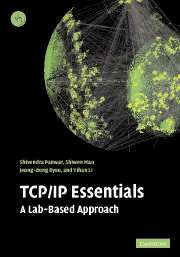Book contents
- Frontmatter
- Contents
- Preface
- Acknowledgements
- General conventions
- List of abbreviations
- 0 TCP/IP overview
- 1 Linux and TCP/IP networking
- 2 A single segment network
- 3 Bridges, LANs and the Cisco IOS
- 4 Static and dynamic routing
- 5 UDP and its applications
- 6 TCP study
- 7 Multicast and realtime service
- 8 The Web, DHCP, NTP and NAT
- 9 Network management and security
- References and further reading
- Appendix A Instructor's guide
- Appendix B Initial configuration of the routers
- Appendix C Source code
- Appendix D List of key requests for comments (RFC)
- Index
5 - UDP and its applications
Published online by Cambridge University Press: 05 June 2012
- Frontmatter
- Contents
- Preface
- Acknowledgements
- General conventions
- List of abbreviations
- 0 TCP/IP overview
- 1 Linux and TCP/IP networking
- 2 A single segment network
- 3 Bridges, LANs and the Cisco IOS
- 4 Static and dynamic routing
- 5 UDP and its applications
- 6 TCP study
- 7 Multicast and realtime service
- 8 The Web, DHCP, NTP and NAT
- 9 Network management and security
- References and further reading
- Appendix A Instructor's guide
- Appendix B Initial configuration of the routers
- Appendix C Source code
- Appendix D List of key requests for comments (RFC)
- Index
Summary
The principle, called the end-to-end argument, suggests that functions placed at low levels of a system may be redundant or of little value when compared with the cost of providing them at that low level.
J. H. Saltzer, D. P. Reed and D. D. ClarkObjectives
Study sock as a traffic generator, in terms of its features and command line options.
Study the User Datagram Protocol.
IP fragmentation.
MTU and path MTU discovery.
UDP applications, using the Trivial File Transfer Protocol as an example.
Compare UDP with TCP, using TFTP and the File Transfer Protocol.
The User Datagram Protocol
Since the Internet protocol suite is often referred to as TCP/IP, UDP, it may seem, suffers from being considered the “less important” transport protocol. This perception is changing rapidly as realtime services, such as Voice over IP (VoIP), which use UDP become an important part of the Internet landscape. This emerging UDP application will be further explored in Chapter 7.
UDP provides a means of multiplexing and demultiplexing for user processes, usingUDP port numbers. It extends the host-to-host delivery service of IP to the application-to-application level. There is no other transport control mechanism provided by UDP, except a checksum which protects the UDP header (see Fig. 0.14), UDP data, and several IP header fields.
- Type
- Chapter
- Information
- TCP/IP EssentialsA Lab-Based Approach, pp. 100 - 110Publisher: Cambridge University PressPrint publication year: 2004



